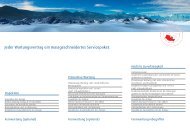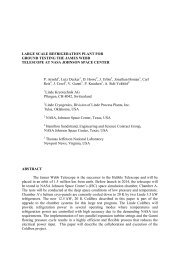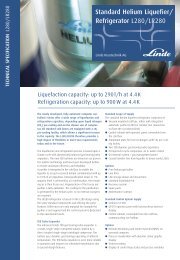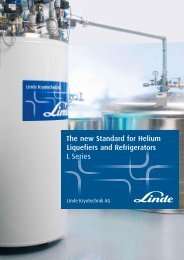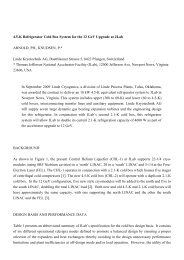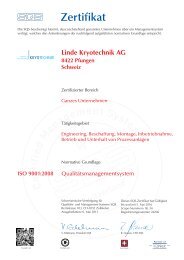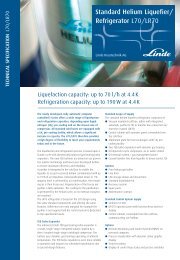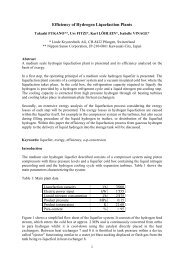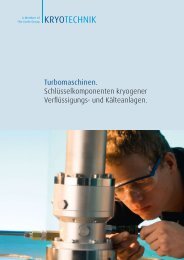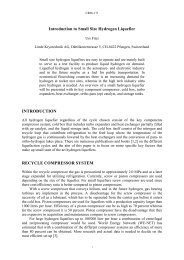example manuscript for advances in cryogenic engineering - Linde ...
example manuscript for advances in cryogenic engineering - Linde ...
example manuscript for advances in cryogenic engineering - Linde ...
Create successful ePaper yourself
Turn your PDF publications into a flip-book with our unique Google optimized e-Paper software.
CONSIDERATIONS FOR SMALL TO MEDIUM<br />
LIQUEFACTION PLANTS<br />
J. Clausen<br />
L<strong>in</strong>de Kryotechnik AG<br />
Pfungen, CH-8422, Switzerland<br />
ABSTRACT<br />
The basic requirements <strong>for</strong> a user to size and design small to medium helium<br />
liquefaction systems are quite multilayer. The feed gas composition, <strong>for</strong> <strong>example</strong>,<br />
def<strong>in</strong>es whether impurities can be removed by an <strong>in</strong>ternal adsorber system or if a purifier<br />
(<strong>in</strong>ternal or external) is required and if the purification operation is a cont<strong>in</strong>uous or batch<br />
process.<br />
The liquefaction rate of the system furthermore is dependant on the runn<strong>in</strong>g time,<br />
e.g. if the system is operated dur<strong>in</strong>g the whole week or stopped on weekends and if a<br />
turn-down of the system is required. This will also determ<strong>in</strong>e the size of the liquid dewar<br />
and storage tank.<br />
Another important issue is the availability of liquid nitrogen <strong>for</strong> pre-cool<strong>in</strong>g<br />
purposes. In the US liquid nitrogen is a commodity with a liter price equal to the price<br />
<strong>for</strong> a kW hour of electricity, whereas <strong>in</strong> Europe LN 2 is more expensive and used only if<br />
necessary or easily available. In case LN 2 is used the components like the compressor<br />
and coldbox can be smaller with less consumption of electric power.<br />
The presentation will cover a number of issues show<strong>in</strong>g important considerations <strong>in</strong><br />
specify<strong>in</strong>g a helium liquefaction system.<br />
KEYWORDS: Helium Liquefaction, Recovery, Purification.
INTRODUCTION<br />
In order to size and specify the requirements of a helium liquefaction system,<br />
FIGURE 1, like a liquefaction centre at a university, or an <strong>in</strong>stitute or <strong>for</strong> a facility where<br />
superconduct<strong>in</strong>g components like MRI magnets are manufactured a number of different<br />
issues have to be considered. This paper describes some of the important issues to be<br />
looked at.<br />
The <strong>for</strong>ego<strong>in</strong>g recovery system is not part of the paper. It has there<strong>for</strong>e been assumed<br />
that the liquid helium distributed with<strong>in</strong> the university, <strong>in</strong>stitute or facility after evaporation<br />
has been collected <strong>in</strong> a gas bag or other low pressure storage and further compressed to<br />
high pressure and stored at a pressure of typically 200 bar.<br />
Additional assumptions are:<br />
Small to medium liquefaction systems with capacities from 20 to 400 l/h<br />
The air impurities conta<strong>in</strong>ed <strong>in</strong> the recovered helium are <strong>in</strong> the range of a few hundred<br />
ppm up to 10%.<br />
REQUIRED SIZE OF THE LIQUEFACTIN SYSTEM<br />
The correct siz<strong>in</strong>g and specification of the liquefaction system is dependant on a<br />
number of operat<strong>in</strong>g conditions such as:<br />
Cont<strong>in</strong>uous or <strong>in</strong>termittent operation<br />
Future <strong>in</strong>crease of helium volume<br />
Availability/use of LN 2 <strong>for</strong> pre-cool<strong>in</strong>g<br />
Level of air impurities <strong>in</strong> the recovered helium<br />
Type of purification system<br />
Loss of helium <strong>in</strong> the system and recovery rate<br />
Turn-down requirements (e.g. weekends)<br />
Available budget and anticipated operational cost<br />
Def<strong>in</strong>ition of liquefaction capacity<br />
FIGURE 1. Liquefaction system
A liquefaction rate def<strong>in</strong>ed as ris<strong>in</strong>g level <strong>for</strong> <strong>example</strong> is measured as the <strong>in</strong>crease of the<br />
liquid level <strong>in</strong> the LHe Dewar over time under the condition that the displaced cold vapour<br />
is re-condensed. This measured rate shows approximately 20% more capacity than the real<br />
feed rate to the liquefier.<br />
LIQUID NITROGEN PRE-COOLING<br />
The use of liquid nitrogen (LN 2 ) as a pre-coolant provides advantages to the<br />
liquefaction system. Instead of us<strong>in</strong>g expansion mach<strong>in</strong>es to generate the required<br />
refrigeration, LN 2 is used to cool down the feed gas from ambient temperature to almost<br />
80K and to cover heat transfer losses between the counter current flows <strong>in</strong> the heat<br />
exchangers. This reduces the size of the compressor, oil removal, heat exchanger, pip<strong>in</strong>g<br />
and valves as well as the power <strong>in</strong>put. As a rule of thumb 1 litre/h of LN 2 is equivalent to a<br />
power <strong>in</strong>put of 1.2 kW <strong>for</strong> the above mentioned liquefaction systems. Advantages of LN 2<br />
Pre-cool<strong>in</strong>g are:<br />
Smaller size of equipment such as the compressor & heat exchangers<br />
Less expansion mach<strong>in</strong>es<br />
Less <strong>in</strong>vestment cost<br />
Improved turndown possibility<br />
Less electrical power <strong>in</strong>put<br />
Less space and <strong>in</strong>stallation cost<br />
Constant temperature profile <strong>in</strong> the heat exchangers<br />
Reduced cool-down time of coldbox<br />
On the other hand the liquefaction system is dependant on the cont<strong>in</strong>uous supply of LN 2<br />
and requires a LN 2 <strong>in</strong>frastructure <strong>in</strong>clud<strong>in</strong>g storage tanks and transfer l<strong>in</strong>es. In case of an<br />
<strong>in</strong>terruption of the LN 2 supply the liquefaction rate will drop drastically.<br />
In many countries “e.g. North America and Japan” LN 2 is a commodity and widely<br />
used as a pre-coolant <strong>in</strong> <strong>cryogenic</strong> plants. However the operational cost of the system can<br />
be substantial higher if the price <strong>for</strong> LN 2 is much above the cost of electric power.<br />
HELIUM PURIFICATION<br />
The air impurities conta<strong>in</strong>ed <strong>in</strong> the recovered helium of such liquefaction systems are<br />
rang<strong>in</strong>g from a few hundred parts per million up to 10%. The goal <strong>for</strong> a helium recovery<br />
system should always be to m<strong>in</strong>imize the level of contam<strong>in</strong>ation <strong>in</strong> order to reduce the<br />
consumption of electric power and LN 2 .<br />
Based on the impurity level different types of purification systems can be used. If the<br />
impurity level is <strong>in</strong> the percentage range either an external LN 2 cooled purifier or an<br />
<strong>in</strong>ternal freeze-out purifier can be used.
FIGURE 2. Process Flow Diagram External Purifier. Helium purification flow path is<br />
highlighted, other l<strong>in</strong>es show adsorber switch<strong>in</strong>g and regeneration.<br />
External Stand-alone Purifier<br />
The external purifier would be located upstream of the liquefier coldbox <strong>in</strong> a separate<br />
<strong>in</strong>sulated coldbox whereas the <strong>in</strong>ternal purifier is an <strong>in</strong>tegral part of the liquefier coldbox.<br />
The process of an external purifier, FIGURE 2, uses LN 2 as coolant to cool down the<br />
impure helium and the ma<strong>in</strong> quantity of the air will be liquefied followed by an adsorber<br />
system to take out the rema<strong>in</strong><strong>in</strong>g air impurities. The pure helium is warmed up aga<strong>in</strong> to<br />
ambient temperature by the impure helium enter<strong>in</strong>g the purifier coldbox and comb<strong>in</strong>ed<br />
with the recycle stream discharged by the recycle compressor.<br />
Advantages of the external purifier are:<br />
Stand alone system with no impact on the liquefaction rate<br />
Helium with high percentage of air can be processed<br />
Only the contam<strong>in</strong>ated helium stream is processed<br />
Cont<strong>in</strong>uous purification with redundant systems is possible<br />
Purified helium can be supplied at compressor discharge pressure<br />
The downside is:<br />
Separate coldbox needed plus additional space & <strong>in</strong>stallation<br />
High <strong>in</strong>vestment cost<br />
LN 2 <strong>in</strong>frastructure required with separate LN 2 connection<br />
Integrated Freeze-out Purifier<br />
The <strong>in</strong>tegrated freeze-out purifier, FIGURE 3, uses cold helium supplied from the<br />
refrigeration process <strong>in</strong>stead of LN 2 <strong>for</strong> the purification process. Impure helium enter<strong>in</strong>g<br />
the coldbox is cooled by a 30K helium stream and the ma<strong>in</strong> part of the conta<strong>in</strong>ed air is
liquefied <strong>in</strong> a heat exchanger. With<strong>in</strong> these heat exchangers the rema<strong>in</strong><strong>in</strong>g air impurities are<br />
removed. The pure helium is warmed up aga<strong>in</strong> to ambient temperature and comb<strong>in</strong>ed<br />
upstream of the coldbox with the helium discharged from the recycle compressor.<br />
Advantages of the <strong>in</strong>ternal purifier are:<br />
Less cost, <strong>in</strong>tegral part of the liquefaction coldbox<br />
Operation without LN 2 possible at reduced liquefaction rate<br />
Same LN 2 supply / return connection used as <strong>for</strong> coldbox<br />
Cont<strong>in</strong>uous operation due to regeneration cycle<br />
Only the impure helium stream is processed<br />
Freeze out of air impurities up to 10%<br />
Cont<strong>in</strong>uous liquefaction due to pure helium storage buffer<br />
Purified helium is returned at compressor discharge pressure<br />
The disadvantages are:<br />
Reduction of liquefaction rate<br />
Pure helium buffer required<br />
The purification / liquefaction system as shown allows cont<strong>in</strong>uous liquefaction<br />
operation. The cycle starts with the purification of impure helium. At the beg<strong>in</strong>n<strong>in</strong>g the<br />
pure helium is distributed partially to the pure helium storage buffer and partially liquefied<br />
<strong>in</strong>to the LHe dewar until a certa<strong>in</strong> pressure <strong>in</strong> the buffer is reached. From that po<strong>in</strong>t on all<br />
purified helium is liquefied <strong>in</strong>to the dewar. At the time the pressure drop <strong>in</strong> the purifier has<br />
reached a certa<strong>in</strong> level the regeneration cycle starts with a warm-up of the purifier followed<br />
by a purge procedure.<br />
Dur<strong>in</strong>g the regeneration period pure helium will be drawn from the storage tank and<br />
liquefied <strong>in</strong>to the dewar. At the end of the regeneration the purifier is cooled down aga<strong>in</strong><br />
by a cold stream supplied from the liquefaction process and the purification cycle starts<br />
aga<strong>in</strong>.<br />
FIGURE 3. Internal Purifier Process Flow Diagram
Adsorber at 80K Level<br />
A different way of <strong>in</strong>tegrated helium purification is to use an adsorber filled with<br />
charcoal or molsieve located at the 80 K level <strong>in</strong>side the liquefier coldbox, FIGURE 4.<br />
Cont<strong>in</strong>uous operation is possible by us<strong>in</strong>g a system of two 80K adsorbers whereas<br />
one adsorber is <strong>in</strong> operation while the second one is regenerated. LN 2 is used <strong>for</strong> precool<strong>in</strong>g<br />
and keeps the adsorber system at a constant temperature to adsorb air impurities.<br />
The advantages of an 80K adsorber are as follows:<br />
No or only little impact on liquefaction rate<br />
Cont<strong>in</strong>uous purification with redundant adsorbers<br />
Internal part of coldbox<br />
Located upstream of turb<strong>in</strong>es<br />
Purification possible with and without use of LN 2<br />
The disadvantages are:<br />
Air impurities limited up to a few hundred of ppm<br />
Full helium flow is processed through adsorber<br />
Special provisions needed <strong>in</strong> case of LN 2 loss<br />
External regeneration equipment needed with some He losses<br />
FIGURE 4. Adsorber at 80K level
FIGURE 5. Adsorber temperature after loss of LN 2<br />
FIGURE 6. Adsorber temperature with<br />
activated control valve CV2<br />
Special provision has to be taken <strong>in</strong> case of loss of LN 2 which will result <strong>in</strong> a warmup<br />
of the adsorber, refer to FIGURES 5 & 6.<br />
The loss of LN 2 will result <strong>in</strong> an <strong>in</strong>crease of the temperature with<strong>in</strong> the adsorber bed<br />
and release air impurities <strong>in</strong>to the liquefaction cycle. The contam<strong>in</strong>ated helium is mov<strong>in</strong>g<br />
to lower temperatures with the possibility of block<strong>in</strong>g the heat exchangers or damage to the<br />
expansion mach<strong>in</strong>e. This can be avoided by temperature control and a special arrangement<br />
of control valves upstream of the turb<strong>in</strong>e, see FIGURE 6. If the temperature TC <strong>in</strong>creases<br />
control valve CV2 will open and bypass a part or the whole helium flow around HX2.<br />
Bypass<strong>in</strong>g HX2 <strong>for</strong>ces a temperature drop downstream of HX3 and lower temperature of<br />
the adsorber to avoid desorption of air impurities.<br />
PERFORMANCE INCREASE<br />
Besides choos<strong>in</strong>g LN 2 <strong>for</strong> pre-cool<strong>in</strong>g or the correct purification system there are<br />
other issues to <strong>in</strong>crease the per<strong>for</strong>mance or to optimize the liquefaction system. Transfer<br />
losses dur<strong>in</strong>g liquid transfer due to the pressure difference between the stationary dewar<br />
and a mobile dewar are a major loss of liquid product. Transfer losses can be decreased by<br />
reduc<strong>in</strong>g the pressure difference with the disadvantage of a longer fill<strong>in</strong>g time of mobile<br />
dewars.
Pure Recovered Helium<br />
Discharge<br />
Pressure<br />
FIGURE 7. Cold Ejector & LHe Pump<br />
Suction<br />
Pressure<br />
Recycle<br />
Compressor<br />
Recycle<br />
Helium<br />
Recovered Pure Helium<br />
FIGURE 8. Feed supply pressure<br />
Cold Ejector & LHe Pump<br />
A more sophisticated but also more costly way to reduce transfer losses is the use of a<br />
cold ejector <strong>in</strong> the coldbox and an immersed liquid helium pump <strong>in</strong> the stationary dewar,<br />
refer to FIGURE 7.<br />
The cold gas <strong>in</strong> the LHe dewar is recovered by a cold ejector, located <strong>in</strong> the coldbox,<br />
by reduc<strong>in</strong>g the pressure at the same time. An immersed liquid helium pump transfers the<br />
liquid helium to a mobile dewar at almost the same pressure without losses. This<br />
arrangement requires also a special transfer l<strong>in</strong>e and the use of a scissor lift to adjust and<br />
connect the mobile dewar to the rigid transfer l<strong>in</strong>e.<br />
Feed Supply Pressure<br />
Also the supply pressure of the pure feed to the liquefaction system has an impact on<br />
the efficiency. If the feed is supplied to the suction l<strong>in</strong>e of the recycle compressor this flow<br />
has to be compressed to the discharge pressure, refer to FIGURE 8.<br />
This reduces the helium stream available by the compressor and turb<strong>in</strong>es <strong>for</strong><br />
generat<strong>in</strong>g the required refrigeration with the result of a lower liquefaction rate at the same<br />
power <strong>in</strong>put<br />
CONCLUSION<br />
Besides the basic considerations like operation periods, future <strong>in</strong>crease of capacity,<br />
and use of LN 2 pre-cool<strong>in</strong>g there a number of conditions to be def<strong>in</strong>ed and specified <strong>for</strong> a<br />
liquefaction system. Based on the results it will be possible to customize a liquefaction<br />
system with the best per<strong>for</strong>mance, lowest <strong>in</strong>vestment and operation costs.



